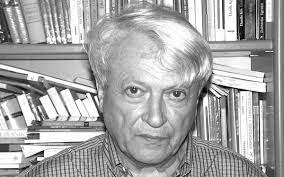Goldmann, Lucien

Bio: (1913-1970) Romanian-French philosopher and sociologist. Lucien Goldmann was born in Romania and studied in Bucharest, Vienna, and Paris. After the Nazi conquest of France, he moved to Switzerland where he received his doctorate in philosophy. After the end of the Second World War, he returned to France and completed another doctorate, this time at the Sorbonne. He has taught and worked at institutes and universities in France and Belgium. Although he ideologically belonged to Marxism, he wanted to create a different epistemological basis for Marxism, and he called his approach genetic structuralism. This approach was a combination of genetic epistemology developed by Jean Piaget and dialectical Marxism by Lukács. Apart from his contributions to philosophy and epistemology, Goldmann is also important for the sociology of literature.
Goldmann believed that Marx, Georg Wilhelm, Friedrich Hegel, and Sigmund Freud all used genetic structuralism in their work, although they did not use the term to describe their approach. Goldmann opposes genetic structuralism to purely deterministic interpretations of society (which he called „atomism”), on the one hand, and non-genetic structuralism. Atomism seeks to explain phenomena by causal relations, necessities, or general interrelationships. Non-genetic structuralism views structures as permanent and universal. Genetic structuralism believes that mental structures arise, and are constantly changing, through human activity, that is, through the practice of a limited social group. As new mental structures are constantly emerging and old ones are constantly changing, the reality is always in the process of structuring and destructing. Unlike Marxists, Goldmann did not think that common mental structures are created only at the class level, but that they can also be created within social groups that are formed on different bases, and that an individual can be a member of several of them. If the members of the group share the intellectual and emotional experience of the world and if the unity of the group is realized, then that group can be viewed as a "transindividual subject".
Structures should be viewed both synchronously and diachronically. In the synchronic perspective, the internal dynamism of the structure is the result of internal contradictions, but it is also a part of the wider structure, which includes the first and strives to establish its own balance. Each phenomenon belongs to a greater or lesser number of structures. Goldmann calls these broader structures "relative totality" and the phenomenon has a special meaning within each of them. From a diachronic perspective, Goldmann studies not only the broader historical processes of structuring and destructuring that led to the formation of the structure but also the dimension of the future. He believes that "every human fact, including mental illness, can only be understood as an actual tension of the forces in a state of dynamic equilibrium, directed towards the future and blockade toward them by the action of forces acting in the opposite direction seeking to thwart such development" (Goldmann, 1970).
In the later period of his life, Goldmann rejected the Marxist idea that the proletariat was a force that would achieve the revolutionary liberation of the human race. He believed that a purely proletarian revolution has never taken place and that the proletariat has integrated into the existing social order. Integration occurred because workers, instead of revolutionary methods, turned to improve their position through political parties and unions. However, workers retain the resistance to reification, that is, to become a commodity themselves. He views the protests and crises of 1968 in the context of the discontent of several groups: the old middle class, traditional workers, ethnic and racial minorities, students dissatisfied with universities, and the radical wing of technicians and intellectuals. It was these protests that gave him hope that social transformation was still possible.
Theoretical approaches
Genetic StructuralismMain works
Mensch, Gemeinschaft und Welt in der philosophie Immanuel Kants: Studien zur Geschichte der Dialektik (1945);
Sciences humaines et philosophie (1952);
Le Dieu caché: Étude sur la vision tragique dans les Pensés de Pascal et dans le théâtre de Racine (1955);
Jean Racine, dramaturge (1956);
Recherches dialectiques (1959);
Pour une sociologie du roman (1964);
Structures mentales et création culturelle (1970);
Marxisme et sciences humaines (1970);
La Création culturelle dans la société moderne (1971);
Lukács et Heidegger: Fragments posthumes établis et présentés par Youssef Ishaghpour (1973).
Works translated into English:
The Hidden God: a Study of Tragic Vision in the Pensees of Pascal and the Tragedies of Racine (1964, in French 1955);
The Human Sciences and Philosophy (1973, in French 1952);
The Philosophy of Enlightenment (1973);
Power and Humanism (1974);
Towards a Sociology of the Novel (1975, in French 1964);
Cultural Creation in Modern Society (1976, in French 1971);
Essays on Method in the Sociology of Literature (1979);
Lukács and Heidegger: Towards a New Philosophy (2009, in French 1973).
Immanuel Kant (2012, in German 1945).

